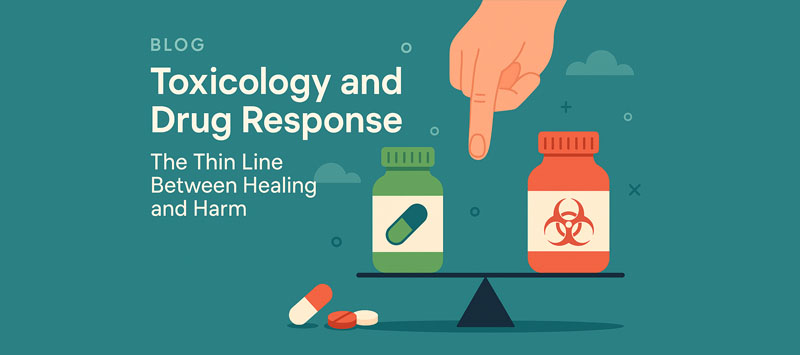
Toxicology and Drug Response: The Thin Line Between Healing and Harm
 |
Aadya Shetty 23FRSB01, B.Sc. Forensic Science, Dept. of Forensic Science, Kristu Jayanti (Deemed to be University) |
When we think of medicines, most imagine quick relief to ease a headache, reduce a fever, or help us sleep. But there's an important truth that's easy to overlook: the same pill that heals can also harm if it's not used correctly.
This is where toxicology comes in—the science that studies how substances, from everyday medicines to chemicals, affect the human body. Toxicology helps us understand what's safe and risky and how a helpful remedy can become harmful in the wrong circumstances.
The Golden Rule: "The Dose Makes the Poison"
One of the most essential principles in toxicology is simple but powerful: any substance can be dangerous in the wrong amount.
• Even something as essential as water can be harmful if consumed in excessive quantities quickly, because it disrupts the body's salt balance.
• Medicines follow the same rule:
o At the correct dose → Healing and relief.
o At too high a dose → Risk of harm to organs, or even life-threatening effects.
Why People React Differently to the Same Medicine
Not everyone responds to medicines in the same way. Several factors shape how our bodies process drugs:
• Age – Babies and older adults often metabolise drugs more slowly.
• Body composition – Fat, muscle, and water levels affect how drugs move within the body.
• Health status – Conditions like liver or kidney problems may prevent drugs from leaving the body properly.
• Genetics – Variations in DNA influence whether a drug is broken down quickly or slowly.
• Mixing substances – Alcohol, certain foods, or other medicines can alter a drug's effect, sometimes making it dangerous.
How Drug Toxicity Appears
Toxic effects may show up suddenly or gradually:
• Acute toxicity – Sudden harm from a single large dose (e.g., taking too many sleeping pills at once).
• Chronic toxicity – Long-term harm from repeated use over time (e.g., prolonged painkiller use linked to kidney damage).
The Safe Zone for Medicines
Every medicine has what scientists call a therapeutic window—a range where it works effectively without causing harm.
• A wide safety zone → Harder to accidentally take too much.
• A narrow safety zone → Even a small extra dose may be risky, so some medicines need careful measurement and monitoring by healthcare professionals.
What Happens If Too Much Is Taken
In cases of overdose or poisoning, doctors may use special treatments known as antidotes to counter harmful effects. For example:
• Naloxone – Can reverse certain opioid overdoses.
• Activated charcoal – Sometimes used to reduce absorption of certain poisons.
• Atropine – Used in specific pesticide-related poisonings.
(Note: Medical professionals handle these treatments, and they should never be self-administered without guidance.)
Key Takeaway
Medicines are powerful tools. When appropriately used, they promote healing; they may cause harm when used carelessly.
To stay safe:
• Follow the prescribed instructions carefully.
• Avoid mixing medicines without professional advice.
• Seek medical help immediately if you suspect an overdose or poisoning.
Toxicology isn't just a scientific subject—it's also about everyday awareness and safety. Remember: more is not always better; sometimes, it can be much worse.
Disclaimer
This blog post is for educational purposes and is not a substitute for professional medical advice, diagnosis, or treatment. Always seek the guidance of a qualified healthcare professional with any questions about medications, toxicology, or your health. Never disregard professional medical advice or delay seeking it because of something you read here.